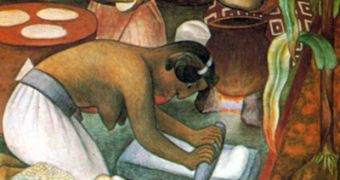Think on an invention that is a wrapping sheet, spoon, plate, and food, all at the same time, which can be eaten accompanying almost any other dish. This is the tortilla, a corn muffin and Mexico's base aliment. Corn is believed to have started being cultivated in Mexico thousands of years ago, and sustained great civilizations like Olmec, Maya, Teotihuacan and Aztec (Mexica).
The tortilla is made by mixing a measure of corn grains with two measures of water on which was solved lime in a concentration of about 1%. The mix is heated till the skin of the grains can be removed by fiddling the grains through the fingers. The heating is stopped by adding cold water, than the mix is left like that till the morning so that the grains settle on the bottom of the recipient.
Next day, the soft grains (nixtamal) are pulled out with the hand from that recipient and put into another for draining off the remaining water. Than the grains are smashed and salt and water are added till the composition turns into a fine mass (masa). The mass is divided in small portions from which, by the hand, round, thin shapes are made. They are put on a large, hot ceramic tray. The tortillas are turned twice from one side to another and when they start to swell upside, they are ready.
Why is lime added to the grains? The lack of niacin (vitamin B3) causes pellagra, manifested through skin inflammation, diarrhea, dementia and can even lead to death. Pellagra is common amongst people whose basic food is corn and experience protein shortage/lack.
The issue is that corn niacin cannot be assimilated by the organism. Instead, the lime turns this niacin partially assimilable. Tortilla stops this way the spread of pellagra in the poor areas of Mexico, except the places where there is the habit of rinsing the grains soft so that the mass is whiter, operation that eliminates the niacin.
The lime also increases the levels of calcium, necessary for bones and nerves. If tortilla is made of whole corn, the dish is also rich in cellulose fibers.
The white, hot tortillas are put in a basket and covered by a white piece of fabric. In fact, tortilla can come in various sizes and colors: white, yellowish, bluish and reddish. Most Mexicans eat tortilla daily at lunch, but also breakfast and dinner.
A basket filled of tortilla is put on the table for the whole family. The fabric is always set back after taking a tortilla for keeping them warm.
Since 1884, automatic machines have been invented for making tortilla. Tortilla may be made by hand today only in rural areas. Most Mexicans buy today tortilla from the store, as here a machine can produce 3,000 to 10,000 tortillas per hour.

 14 DAY TRIAL //
14 DAY TRIAL //